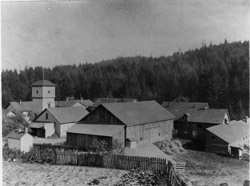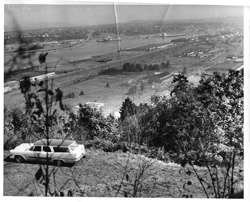Before 1850, the land that is now Hoyt Arboretum was a dense forest of Douglas-fir, Western redcedar, Western hemlock, bigleaf maple, and red alder.
In October 1850, Eli and Ann C. Stewart made the trek across the plains and arrived in Oregon Territory. By April 1851, they had filed and settled a donation land claim for 632 acres, which included what is now Hoyt Aboretum. The Stewarts sold off parts of their claim over the years and, by 1868, Multnomah County acquired 160 acres of the original claim to establish the Hillside Farm, a “Poor Farm” for the infirm and mentally ill where inmates tended stock and took care of an extensive orchard. Because of corrupt supervision and substandard conditions, the Poor Farm was moved to Troutdale in 1911.
Portland Parks Superintendent E.T. Mische saw the Poor Farm moving as an opportunity to start an arboretum on the land. He had been trained at the Olmsted landscape firm in Brookline, Massachusetts. Frederick Law Olmsted, the co-designer of New York’s Central Park and designer of Harvard’s Arnold Arboretum was known to be a firm believer that every city should have an arboretum. It was not, however, until 1928 that Hoyt Arboretum became a reality. In 1922, Multnomah County sold the Poor Farm land to Portland for $10. The city wanted to put the land into home sites and a golf course. However, C. P. Keyser, E.T. Mische’s assistant until his departure, became Superintendent of Parks and carried forward Miche’s idea. In 1928, Keyser convinced several men in lumber and forestry and County Commissioner Ralph Warren Hoyt to start an arboretum in Portland.


When Hoyt Arboretum’s first curator began in 1930, he planted trees according to the 1930 Duncan Plan (trees were grouped by family), created trails and roads, and supervised the golf course construction. Some of the six years he was curator he had help from WPA, CWA, and NYA workers. The first tree was planted in 1930, and by 1936 he had planted over 4,000 trees. Ernie Fischer, who became the next curator in 1940, completed the plant families of the Duncan Plan by 1944. Fischer was curator for 30 years.
During Fischer’s term, the following events impacted the Arboretum: World War II greatly diminished travel opportunities for Portlanders, who, as a consequence, discovered Hoyt Arboretum; in 1959 the zoo arrived and took the land of the golf course (West Hills Golf Course); in 1962, the Columbus Day Storm demolished most of the trees on the south-facing side of the Arboretum. In 1969 and the early 1980s, the Arboretum was viewed as “open space.” In 1969, a ski tow, ski instructions, and food concessions were envisioned but never came to pass, and in the 1980s the Vietnam Memorial was built on 11 acres of Arboretum land. This event led to the creation of Hoyt Arboretum Friends (HAF) in 1986, a nonprofit organization that partners with the City of Portland for funding, volunteer and leadership purposes.


